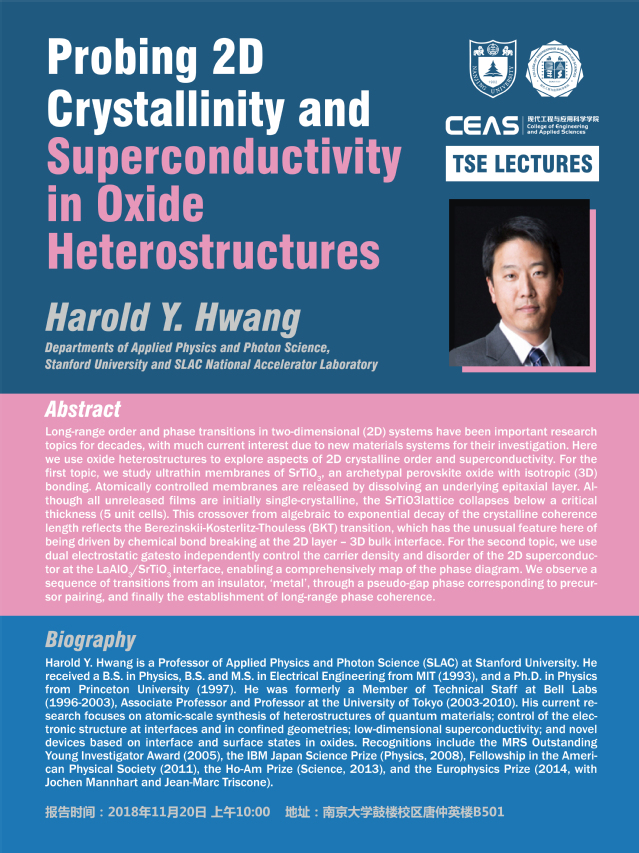Nanjing Distinguished Lecture Series in Transformative Science and Engineering (TSE Lectures) was conceived by a visionary group of faculty and staff at the College of Engineering and Applied Sciences, Nanjing University. The main goal is to invite world-class scholars to visit Nanjing University and to speak on emerging and cross-cutting topics such as new materials, bioengineering, wearable devices, big data, optoelectronics, nanotechnology, and energy.
我们有幸邀请到Stanford University&SLAC National Accelerator Laboratory Prof. Harold Y. Hwang,作为TSE Lectures系列讲座的第五讲嘉宾。报告信息见下,欢迎各位老师和同学参加!
时间:2018年11月20日 上午10:00
地点:唐仲英楼B501报告厅
联系人:袁洪涛教授 Email:htyuan@nju.edu.cn
题目:Probing 2D Crystallinity and Superconductivity in Oxide Heterostructures
摘要:
Long-range order and phase transitions in two-dimensional (2D) systems have been important research topics for decades, with much current interest due to new materials systems for their investigation. Here we use oxide heterostructures to explore aspects of 2D crystalline order and superconductivity. For the first topic, we study ultrathin membranes of SrTiO3, an archetypal perovskite oxide with isotropic (3D) bonding. Atomically controlled membranes are released by dissolving an underlying epitaxial layer. Although all unreleased films are initially single-crystalline, the SrTiO3lattice collapses below a critical thickness (5 unit cells). This crossover from algebraic to exponential decay of the crystalline coherence length reflects the Berezinskii-Kosterlitz-Thouless (BKT) transition, which has the unusual feature here of being driven by chemical bond breaking at the 2D layer – 3D bulk interface. For the second topic, we use dual electrostatic gatesto independently control the carrier density and disorder of the 2D superconductor at the LaAlO3/SrTiO3interface, enabling a comprehensively map of the phase diagram. We observe a sequence of transitions from an insulator, ‘metal’, through a pseudo-gap phase corresponding to precursor pairing, and finally the establishment of long-range phase coherence.
个人简介:
Harold Y. Hwang is a Professor of Applied Physics and Photon Science (SLAC) at Stanford University. He received a B.S. in Physics, B.S. and M.S. in Electrical Engineering from MIT (1993), and a Ph.D. in Physics from Princeton University (1997). He was formerly a Member of Technical Staff at Bell Labs (1996-2003), Associate Professor and Professor at the University of Tokyo (2003-2010). His current research focuses on atomic-scale synthesis of heterostructures of quantum materials; control of the electronic structure at interfaces and in confined geometries; low-dimensional superconductivity; and novel devices based on interface and surface states in oxides. Recognitions include the MRS Outstanding Young Investigator Award (2005), the IBM Japan Science Prize (Physics, 2008), Fellowship in the American Physical Society (2011), the Ho-Am Prize (Science, 2013), and the Europhysics Prize (2014, with Jochen Mannhart and Jean-Marc Triscone).



